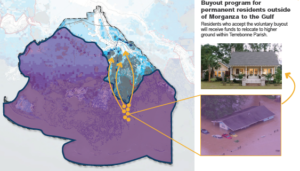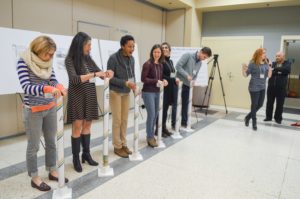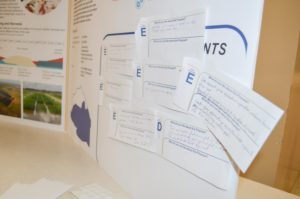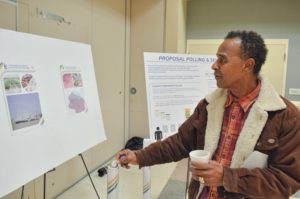Terrebonne Parish Projects Selected for 2018 Funding
Buyouts for Permanent Resident Households
The Buyouts for Permanent Resident Households program is a Resilient Housing project that seeks to relocate the relatively few homeowners still living outside of the Morganza to the Gulf structural protection system.
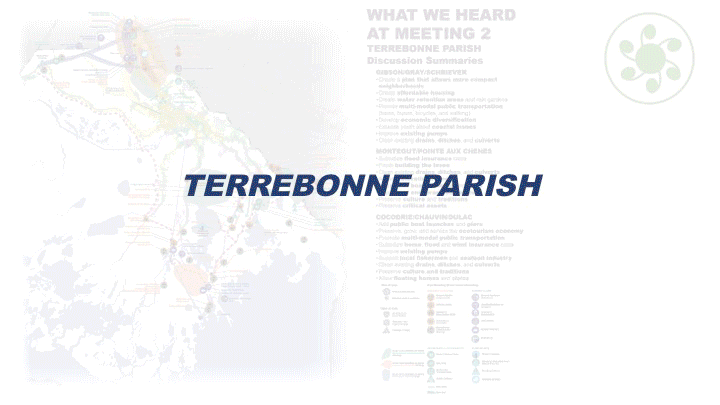
Terrebonne Parish
Terrebonne Parish has been shaped by rivers, bayous and the gulf, the cultures of Native Americans and other early settlers, and an economy largely based on the area’s natural resources. Over 85 percent of the parish is water and wetlands, with freshwater marsh in the northern areas, brackish marshes further south, and saltwater marshes near the coast. The extensive bayous, wetlands, and marshes of Terrebonne provide recreational, agriculture, aquaculture and economic opportunities. In Terrebonne Parish, the natural environment has shaped where residents live and where major business and industries have located. This will continue to be the case in the future, as the parish’s landscape shifts to more open water, less land and increased impacts from future storm surge with the disappearance of the wetland buffer.
See What You’ve Missed
We brought the best land loss and flood risk modeling in the world to the table from our partners at the Coastal Protection and Restoration Authority alongside an exceptional team of public sector, philanthropic, non-profit and private sector partners. Residents brought their own personal experience from communities across parishes as well as their goals and vision for a Louisiana we know and love.
Residents described challenges, strengths and opportunities for the future.
505 participants | 2,000 ideas
The first round of meetings included six community meetings across the six pilot parishes. The LA SAFE team showed information on historic land loss over the last 50 years as well as expected land loss in the next 50 years even with full implementation of the Coastal Master Plan. The team also discussed projected increased flood risk that results from the loss of our wetland buffer and the migration trends taking place across the LA SAFE region. As Louisianans have made the decision to relocate, we have seen resources for everyday services such as education, infrastructure and healthcare shift accordingly.
At roundtable discussions, groups of six to eight residents talked about the ways they have seen land loss impact changes to their environment, economies and communities in their lifetimes. They also discussed what they think are the most important things to protect, and their hopes for the future of their parish.
The project team organized all of the comments into strengths, challenges and opportunities.
In Terrebonne Parish, residents identified population loss, loss of business and industry, and flooding as three of the biggest challenges to the parish, and natural beauty, quality of life, and traditions and cultures as the biggest strengths. They hoped to capitalize on opportunities including economic development and diversification, protection and restoration of land, and job training.
Meeting Summaries Packet
Download a printable version of the complete summary of meeting 1.


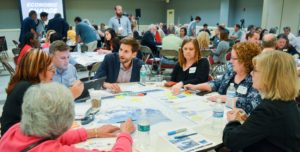



We held 21 meetings at 19 locations within the six pilot parishes. Residents recommended short-term, medium-term and long-term strategies according to projected low, moderate and high flood risk across LA SAFE parishes.
551 participants | 3,300 ideas
The Round 2 LA SAFE meeting focused on conversations in smaller communities. These meetings occurred in 19 specific towns and places suggested by residents in the first round of meetings. Three of the meetings were for non-English speaking communities. These smaller meetings allowed the team to present a more in-depth view of the social, environmental and economic trends in each community, and to conduct a more focused conversation about adaptation strategies to address increased flood risk.
The LA SAFE team identified the most discussed topics from the first round of meetings, and created nine question card topics sorted into three categories: Economy & Jobs, Environment & Sustainability and Community & Culture. At the meeting, residents discussed one topic from each category, and placed ideas on the map provided. For each card, residents described short-term (within 10 years), medium-term (within 25 years) and long-term (within 50 years) solutions for adapting to future land change and increased flood risk. Looking 50 years back and 50 years forward, residents discussed the challenges and opportunities for themselves, for their children and grandchildren as well as generations to come.
In this series of 21 community meetings, residents pinpointed challenges, proposed solutions and collectively described a future across different types of environments and different levels of risk. The project team combined their ideas and mapped proposed strategies. These community recommendations will form the basis for the projects, programs and policies that LA SAFE pursues. The project team will review these ideas, taking into consideration current and future environmental risk, as well as the best practices in planning.
In Terrebonne Parish, meetings were held for the Gibson/Gray/Schriever, Montegut/Pointe Aux Chenes, and Cocodrie/Chauvin/Dulac areas. Stormwater management, property values and cost of living, and quality of life were the issues residents in these areas discussed most at the second round of meetings.
Meeting Summary Packet
Download a printable version of the complete summary of meeting 2.
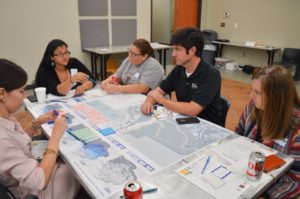

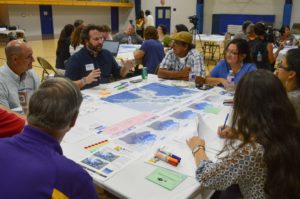
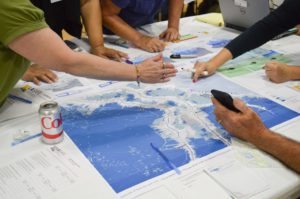
We returned to each parish with a broad vision for our coast, including more specific visions for communities according to low, moderate and high flood risk. Residents evaluated these visions and prioritized more detailed strategies in table discussions.
In the Round 3 meeting, the project team presented an overall vision based on the combination of three criteria: The vision residents described at previous community meetings, current and future environmental conditions and the best planning practices.
At the meetings, residents engaged in a series of instant polling questions using a real-time polling tool, and then evaluated the overall vision presented by the project team. Then, they reviewed and gave preference feedback on a wide range of strategies that the project team is considering for inclusion in the final strategy. Residents used stickers to indicate which strategies are the best fit for their parish and added more ideas and comments.
Activity two focused on the range of projects, programs and policies that residents had proposed according to low, moderate and high flood risk in previous meetings. Residents discussed the strategies shown and used green and red stickers to indicate which strategies they liked or disliked for each of those flood risk levels.
In Terrebonne Parish, a strong majority of residents agreed or strongly agreed with the visions presented for the parish. At the Terrebonne meeting, the most selected strategy across all categories was “Summer Camp Restoration Program”, which reinforces the parish’s focus on educating the youth to be proactive about preserving the coast. Residents’ selections were very balanced across the Transportation and Housing & Development topics. They see the need for a variety of transportation services including complete streets, bus transportation, bridges and boat docks. They also want to see safe, affordable and elevated homes with nearby services. However, there was a strong disdain for “High Density Housing”, receiving as many red stickers as the top choices in the same category. In the Stormwater Management & Greenspace and the Education, Economy, & Jobs categories, residents emphasized not only protecting against the present flooding issues but being proactive about the future of the parish. Residents want culvert maintenance and a cross-parish stormwater management strategy. Simultaneously, they are drawn to job training programs, particularly in coastal restoration and renewable energies.
Meeting Summary Packet
Download a printable version of the complete summary of meeting 3.

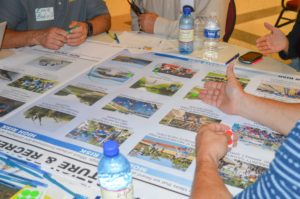
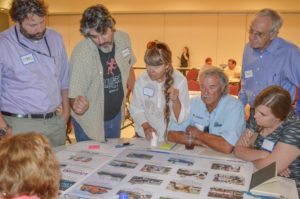

ROUND 4: COMMUNITY MEETINGS
In this fourth round of engagement, residents had the opportunity to review and provide feedback on the draft strategies developed by the LA SAFE team after several rounds of collaborative meetings over the course of the year. These draft strategies were presented in a variety of settings included focused discussions with participants from previous meetings, including public and elected officials; casual open-house gatherings; and table presentations at local festivals and other public spaces. The planning team has taken these final suggestions into consideration as they completed the design of the potential adaptation strategies for each parish that addresses challenges and opportunities unique to that parish.
Meeting Summary Packet
See Meeting 5 for downloadable Meeting 4 and 5 Summary.


ROUND 5: COMMUNITY MEETINGS
In this fifth round of engagement, residents had the opportunity to offer their preference on the final product of our collaboration together, learn more about what is next for their parish’s adaptation strategy and celebrate everyone’s hard work with music, art, food and other staples of your parish’s diverse culture.
During our fifth and final round of meetings, residents also had the opportunity to rank their favorite projects that have come as a result of our work together. Preferences provided by parish residents will be a key component in determining which catalytic project or program will be implemented in your parish.
Terrebonne Parish Pilot Project Boards
Download a printable version of the Terrebonne Parish Project Boards.
Meeting Summary Packet
Download a printable version of the complete summary of meetings 4 and 5.

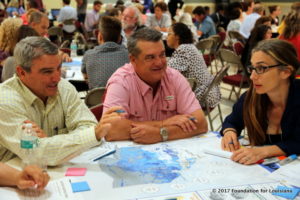
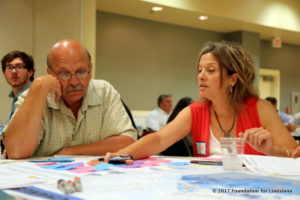
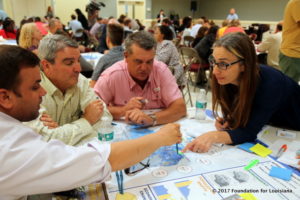
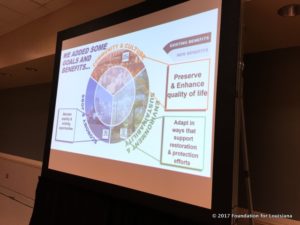
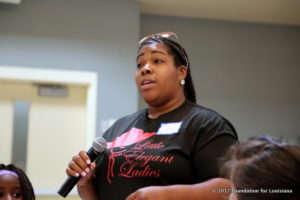
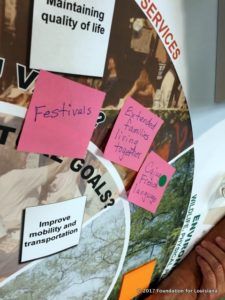
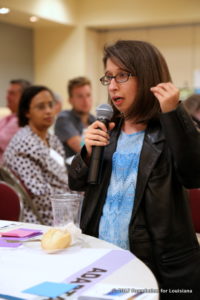
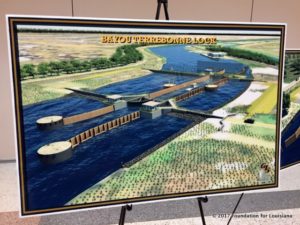
We Need You! Get Involved Today.
Interested in leading a table discussion at the next meeting or hosting a community event? Let us know! We look forward to having you assist us in creating a better future environment for Louisiana.

